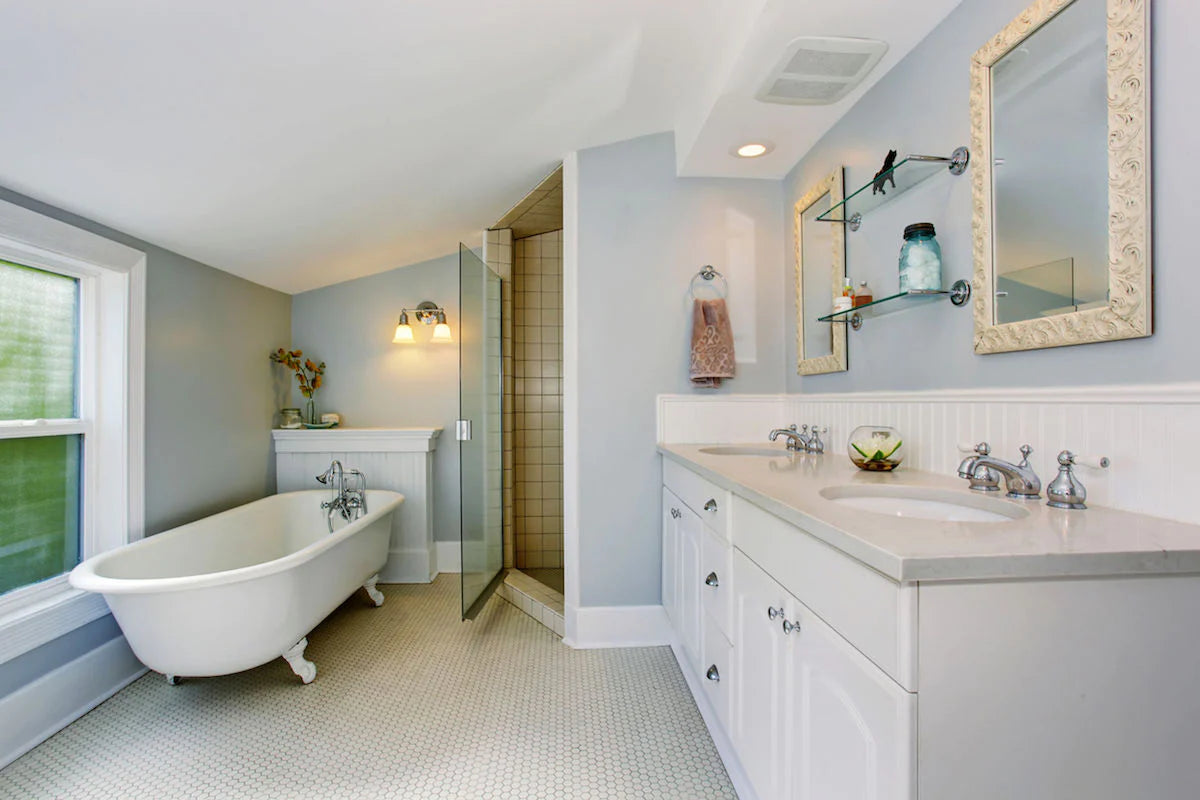Painting over a cast iron tub can give new life and style to any bathroom. Whether the bathtub is rusted and peeling or simply in need of a refresh, it’s important to plan each step in the process. Here’s everything you need to know about repainting a cast iron tub so that it stays beautiful for years to come.
What is Cast Iron Tub Refinishing?
Bathtub refinishing involves sanding down the tub’s surface, filling in cracks and applying several coats of primer before rebuffing. Also known as reglazing or repainting, the process is just as transformative as a renovation, albeit with much less effort, says Amanda Sims, digital design editor at Architectural Digest.
“A professional will come to your home and, after a deep cleaning of the bathroom in question, spray a very thin, opaque, gleaming coat of enamel across the tile, sink, tub, or all of the above—wholly transforming the room in a matter of hours,” she writes.
A professional tub and tile refinisher can tell you if refinishing is worth the money. Chuck Pistor, president of bath and kitchen refinishing company Miracle Method, says refinishing a tub is somewhat like recycling in place. It keeps construction materials from landing up in a landfill and costs less than replacing the tub entirely.
Refinishing is a process that can be applied to a number of items in the bathroom. For example, an outdated tub and surrounding tile can be refinished at the same time. However, you can also be selective about which elements you’d like to resurface and those you’d like to preserve or replace.
And it’s not just a one-time event. Refinishing a tub is a process that can and should be repeated numerous times throughout a bathtub’s lifetime. “Think of it like you’re putting nail polish on your nails. It’s nice for a little bit, but then as you go through your daily routine, you’re going to need to get it touched up again,” says Jennifer Wagner, a merchant for Home Depot’s home services.
What to Consider When Refinishing a Tub
There are many reasons why homeowners choose to repaint their tub. Bathing should be a relaxing and rejuvenating experience, but it’s hard to enjoy a bath if the tub is rusted or cracked. Repainting is a better option than relining, home renovation expert Lee Wallender explains. He adds that relining a tub merely covers up existing problems. Relining also costs about the same or more than repainting a bathtub. One benefit of relining, however, is that the lining won’t wear away like a new finish. Still, refinishing is probably a better way to retain the character of a vintage or unique tub.
Time is another factor to think about when creating a tub refinishing plan: It takes at least three days to dry, according to home improvement writer Jennifer Noonan. She points out that even if the tub feels dry to the touch, it will need a full 72 hours until it is fully cured. Planning for this time is important because you don’t want to be stuck without a place to bathe in your home. And, waiting until the finish has set can ensure that your beautiful new finish isn’t disrupted or warped by running water.
For homeowners interested in the resale value of their home, refinishing is a smart option, explains Casey Pollock at Maryland-based remodeling company Custom Tub and Tile. “Having a gleaming, clean bathtub is a critical component in impressing buyers and swaying them towards making a decent offer. A refinished bathtub can mean more buyers and better offers.”
Moreover, tub refinishing is a relatively simple way to increase the long-term value of your home. And even if you’re not thinking about selling just yet, a new tub can help you enjoy your own bathroom even more than before.

Choosing Paint and Finishes
Certain tub materials work better with different types of paint, Daisy Cuinn at Hunker writes. This is primarily because the right paint can ward off rust, which tends to be an issue with cast iron tubs either due to improper care or simply the passage of time.
“Rust is the enemy, and if the exterior coating wears out, the rust (especially around the drain) can be quite ugly,” says historic preservationist Brent Hull. He adds that restoring cast iron tubs with a new epoxy finish can prevent future rust. This is true for both vintage tubs and for reproductions that can be purchased new.
Certain paint compounds can actually damage cast iron.
“Water-based latex and acrylic primers do not work on cast iron because the surface is too nonporous to absorb the primer adhesives. If you use either one of these primers on a cast iron surface, flaking will occur within months of application,” says Ryan Lawrence at eHow.
He suggests applying a galvanized metal-etching primer to the tub after it has been cleaned and sanded. He explains that this base promotes acidic bonding, which adheres well to the cast iron. The result is a beautiful, long-term finish that doesn’t flake or peel.
Apartment Therapy writer Ashley Poskin used Rust-Oleum latex primer and enamel paint on her bathtub. After three coats of paint, the tub’s body looked new. Poskin also suggests sandblasting the cast iron tub to prepare it for painting, as this reduces imperfections and achieves a smooth surface.
Whether or not your tub has been painted before also matters. Sarah Gibson, founder of the Room for Tuesday lifestyle blog, explains how she resurfaced her cast iron tub. She points out that if the tub had been painted before, it would have needed to be stripped and sanded. This requires additional work and money, but a resurfacing consultant can give you a quick assessment if you’re not sure. Gibson’s cast iron tub hadn’t been painted before, so she was able to start cleaning and prepping it for painting right away.

Preparing the Tub
The surface of the bathtub also needs to be prepared properly, Dan Harmon writes at home and garden site, DenGarden. First, the tub need to be thoroughly cleaned and cleared, which entails removing all tapware and hardware. If a shower door happens to be attached to the tub, it should also be removed, advises Harmon. Removal is easier than masking and painting around the bottom track.
The bathtub can be cleaned using a commercial cleanser. This ensures that tough grime and soap scum is removed, explains the team at Colorado Tub Repair. They recommend phosphoric acid to prep the tub, to flush the pores out and create the adhesion. Caulk should be removed from around the bathtub too. Both steps are important for obtaining a clean, professional looking finish.
Removing paint chips and enamel flaking properly is also important during this stage. This is because loose and flaking paint can be a gateway to rusting. A stiff metal brush is great for this, says general contractor Scott Sidler, owner of Austin Historical, a historic restoration company. While his instructions involve repainting a cast iron radiator, they can also be applied to a cast iron bathtub. He suggests scrubbing all the surfaces of the tub until loose paint and dirt has been fully removed. Then, any remaining dirt or paint flecks can be removed with a rag.
After the tub has been primed and painted, it should be finished in a paint that provides a waterproof finish. This is what gives the tub its glassy porcelain look that’s so inviting, according to the team at local services platform Thumbtack. Once the tub has fully dried, fixtures can be returned to their original spots and the tub is ready for bathing.
Images by: Monika Mlynek/©123RF.com, Free-Photos, iriana88w/©123RF.com







